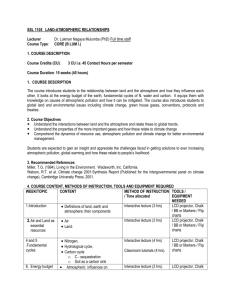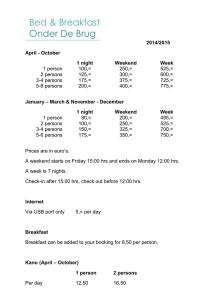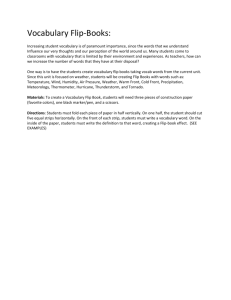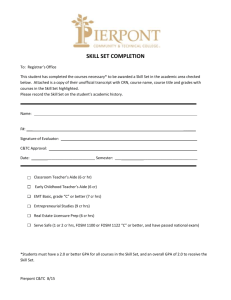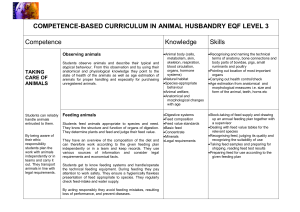COURSEANS 3203 ANIMAL FEEDS AND FEEDING
advertisement
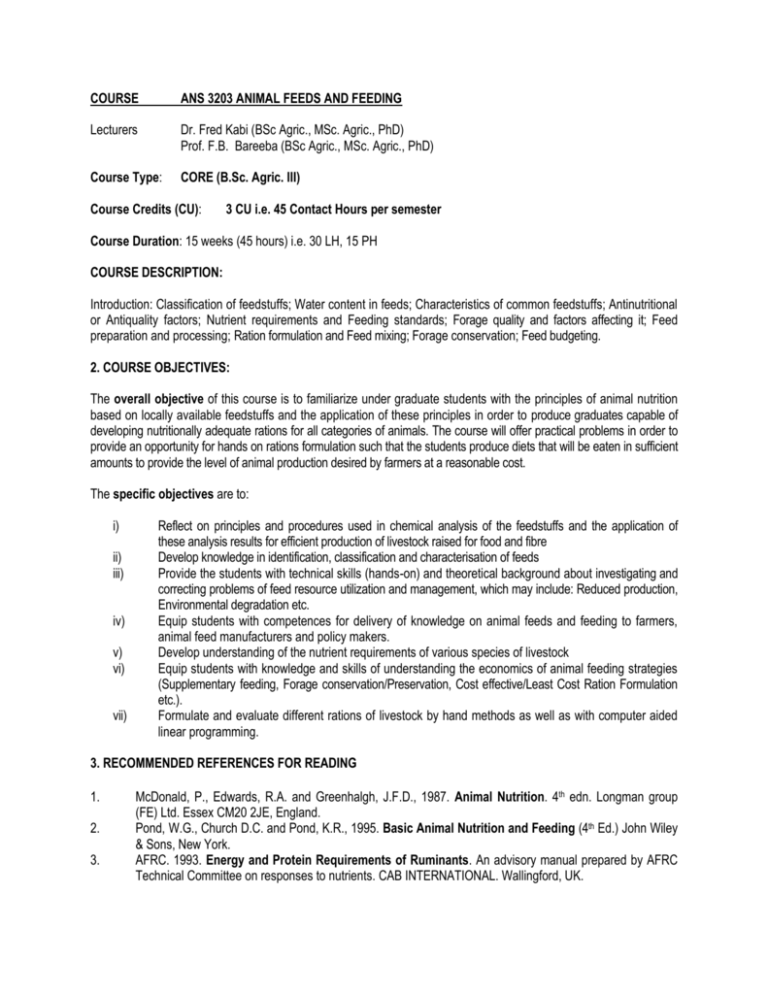
COURSE ANS 3203 ANIMAL FEEDS AND FEEDING Lecturers Dr. Fred Kabi (BSc Agric., MSc. Agric., PhD) Prof. F.B. Bareeba (BSc Agric., MSc. Agric., PhD) Course Type: CORE (B.Sc. Agric. III) Course Credits (CU): 3 CU i.e. 45 Contact Hours per semester Course Duration: 15 weeks (45 hours) i.e. 30 LH, 15 PH COURSE DESCRIPTION: Introduction: Classification of feedstuffs; Water content in feeds; Characteristics of common feedstuffs; Antinutritional or Antiquality factors; Nutrient requirements and Feeding standards; Forage quality and factors affecting it; Feed preparation and processing; Ration formulation and Feed mixing; Forage conservation; Feed budgeting. 2. COURSE OBJECTIVES: The overall objective of this course is to familiarize under graduate students with the principles of animal nutrition based on locally available feedstuffs and the application of these principles in order to produce graduates capable of developing nutritionally adequate rations for all categories of animals. The course will offer practical problems in order to provide an opportunity for hands on rations formulation such that the students produce diets that will be eaten in sufficient amounts to provide the level of animal production desired by farmers at a reasonable cost. The specific objectives are to: i) ii) iii) iv) v) vi) vii) Reflect on principles and procedures used in chemical analysis of the feedstuffs and the application of these analysis results for efficient production of livestock raised for food and fibre Develop knowledge in identification, classification and characterisation of feeds Provide the students with technical skills (hands-on) and theoretical background about investigating and correcting problems of feed resource utilization and management, which may include: Reduced production, Environmental degradation etc. Equip students with competences for delivery of knowledge on animal feeds and feeding to farmers, animal feed manufacturers and policy makers. Develop understanding of the nutrient requirements of various species of livestock Equip students with knowledge and skills of understanding the economics of animal feeding strategies (Supplementary feeding, Forage conservation/Preservation, Cost effective/Least Cost Ration Formulation etc.). Formulate and evaluate different rations of livestock by hand methods as well as with computer aided linear programming. 3. RECOMMENDED REFERENCES FOR READING 1. 2. 3. McDonald, P., Edwards, R.A. and Greenhalgh, J.F.D., 1987. Animal Nutrition. 4th edn. Longman group (FE) Ltd. Essex CM20 2JE, England. Pond, W.G., Church D.C. and Pond, K.R., 1995. Basic Animal Nutrition and Feeding (4th Ed.) John Wiley & Sons, New York. AFRC. 1993. Energy and Protein Requirements of Ruminants. An advisory manual prepared by AFRC Technical Committee on responses to nutrients. CAB INTERNATIONAL. Wallingford, UK. 4. 5. 6. 7. 8. MAAF (Ministry of Agriculture, Fisheries and Food). 1987. Energy allowances and feeding systems for ruminants. Reference book 433. London: Her Majesty’s stationery office. NRC (National Research Council), 1988. Nutrient requirement of Swine. 9th rev. Ed. Natl. Acad. Press, Washington, D.C. NRC (National Research Council), 2001. Nutrient requirement of dairy cattle. 7th rev. Ed. Natl. Acad. Press, Washington, D.C. Mathews, C.K. and van Holde, K.E. 1996. Biochemistry (2nd ed.). The Benjamin/Cummings Publishing Company, Inc. Menlo Park, Calfornia. Ganong, W.F., 1997. Review of medical physiology (18th Ed.) Applenton & Lange medical book. Satmford, Connecticut. 4. COURSE CONTENT, METHODS OF INSTRUCTION, TOOLS AND EQUIPMENT REQUIRED TOPIC CONTENT 1.Classification of feedstuffs 2. Water content in feeds 3. Characteristics of common feedstuffs 4. Antinutritional or Antiquality factors Definitions Rationale for classifying feedstuffs Why classify feedstuffs Classifications with examples of locally available feedstuffs Determining dry matter (DM) content of feeds Estimation of feed intake of livestock basing on DM Different methods of expressing nutrient composition Applied examples (calculations) of nutrient composition of locally available feeds Cereal grains and their by-products Legume grains and their by-products Pastures Roots and tubers Miscellaneous or Unconventional feedstuffs Definitions Different antinutritional factors (ANF) Effects of ANF on nutrient metabolism Control strategies of negative effects of ANF Feedstuffs where ANF found METHOD OF INSTRUCTION / Time allocated Interactive lecture (2 hrs) TOOLS / EQUIPMENT NEEDED Chalk / BB or Markers / Flip charts Interactive lecture (5 hrs) Chalk / BB or Markers / Flip charts Interactive lecture (3 hrs) Chalk / BB or Markers / Flip charts Interactive lecture (5 hrs) Chalk / BB or Markers / Flip charts 5. Nutrient requirements and Feeding standards 6. Forage quality and factors affecting it 7. Feed preparation and processing 8. Ration formulation and Feed mixing Definitions Safety Factor (SF) Estimation of Nutrient requirements by Livestock Practical feeding considerations Interactive lecture (2 hrs) Chalk / BB or Markers / Flip charts Definitions Forage quality factors Voluntary intake (VI) Practical (field) work with any farm Definitions Reasons for processing feeds Grain processing methods Roughage processing methods (for ruminants) Practical (field) work with feed manufacturer Basic information needed before embarking on ration formulation Balancing rations by Hands Perason’s square method Double Pearson’s square method Algebraic method (simultaneous equations) Slack method Illustrating examples (calculations) Computer aided programming (Linear and nonlinear) Benefits of computer aided modeling in Animal production Least cost ration formulation by linear programming Computer lab exercises on least cost formulation Practical work on feed mixing at the University feed mill (MUARIK) Definitions Why conserve forage Ways of conservation Silage Basic principles of making hay Silage microbiology Objective of making silage Factors affecting the ensiling process Silage quality Estimating volume of silage Hay Principles of making hay Hay quality Practical (field) work with any farm Definitions Approaches of feed budgeting Management decisions basing on feed budgets Lecture (3 hr) Practical (3 hrs Chalk / BB or Markers / Flip charts 9. Forage conservation 10. Feed budgeting Lecture (2 hr) Practical (3 hrs Lecture (4 hr) Practical (6 hrs Chalk / BB or Markers / Flip charts/ LCD / Computer lab Lecture (2 hr) Practical (3 hrs Chalk / BB or Markers / Flip charts Lecture (2 hr) Chalk / BB or Markers / Flip charts Supplementary feeding 5. SUMMARY OF TIME NEEDED Interactive lectures covering theory On-station field practicals, Field visits 30 hrs 6 hrs 9 hrs 6. OVERALL COURSE EVALUATION Continuous Assessment Examination Labs, Field trips and Essays Final examination 20% 20% 60%. 40% , tentative date will be Thurs 9th April 09


